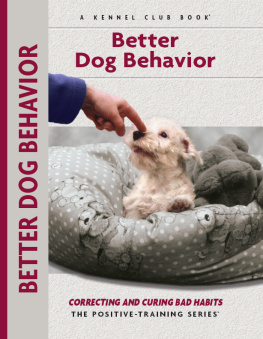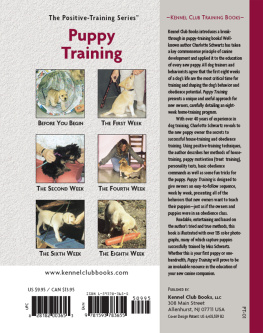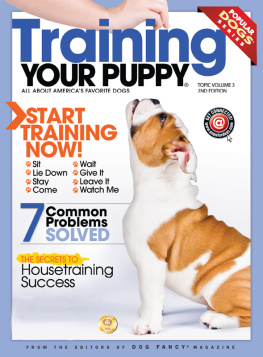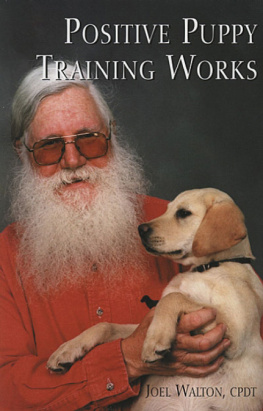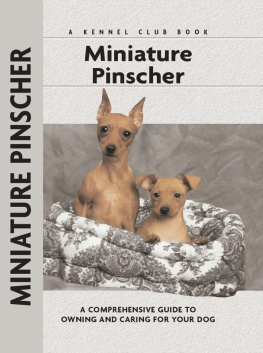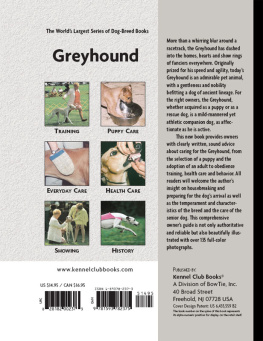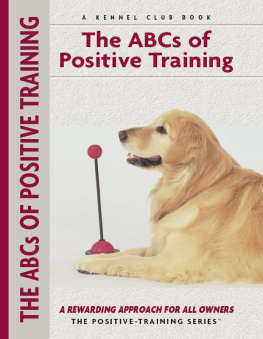IN APPRECIATION
Books are the products of many minds, hands and hearts all working together to make it happen. This book is a perfect example of that.
The photos were taken by Beverly Walter, an accomplished and prize-winning photographer, who spends hours researching her subjects and following them around to catch just the right message in each picture. Thank you, Bev; it has been my privilege to work with you.
Editor Andrew DePrisco, himself a book author of note, makes a great guide for writers trying to convey messages in print. Hes eagle-eyed, understanding and patient, and a pro at mastering the use of the written word. He makes my job look better than I ever thought it could!
As the author, I have used my mind, hands and heart to address and solve the many behavior problems of our canine companions. Each dog Ive lived with and each dog Ive trained has added to my store of knowledge and experience, from which I derive the help I offer herein. It has been a special treat for me to compile this guide and present it to dog owners everywhere. Dogs have made my life an exceptional wonderI hope your dog makes your life wonderful, too.

Photography by Beverly Walter
with additional photos by Mary Bloom, Paulette Braun, Bernd Brinkmann, Isabelle Franais, Carol Ann Johnson, Nancy Liguori, Antonio Phillipe, Alice Roche, Nikki Sussman, Michael Trafford and Alice van Kempen.
KENNEL CLUB BOOKS: BETTER DOG BEHAVIOR
ISBN: 1-59378-379-5
Copyright 2004
Kennel Club Books An Imprint of I-5 Press A Division of I-5 Publishing, LLC
3 Burroughs, Irvine, CA 92618 USA
Cover Design Patented: US 6,435,559 B2 Printed in South Korea
All rights reserved. No part of this book may be reproduced in any form, by photostat, scanner, microfilm, xerography or any other means, or incorporated into any information retrieval system, electronic or mechanical, without the written permission of the copyright owner.
10 9 8 7 6 5 4 3 2 1

Contents
A problem that can occur in dogs of any breed, aggression has different forms and causes. Learn about each type of aggression and remedial methods that owners can try at home.
Some dogs have a lot to say! Learn the difference between instinctive, appropriate barking and excessive nuisance barking, and how to correct the latter.
Acclimate your dog to riding in the car so that you can travel safely and happily together.
Learn about prey drive, hunting instinct and other factors that cause dogs to chase people, other animals, vehicles, etc., and how to discourage this potentially dangerous behavior.
Find out how to direct your dogs chewing needs and energies onto appropriate objects and discourage destructive chewing.
A canine habit considered one of the most disgusting by humans, stool eating is commonly seen in dogs and can be controlled with simple preventative measures.
What dog doesnt love to get his paws dirty every once in a while? Whether your dog is a compulsive or recreational digger, learn how to keep digging from becoming destructive.
If your dog fears certain sounds, the desensitization technique presented here is effective in acclimating him to the noises that usually make him run and hide.
Study a proven crate-training method to teach your dog clean toileting habits and learn how to deal with territorial urine-marking behavior.
Direct your dogs playful exuberance into constructive activities and avoid those which foster aggressive, rough and otherwise undesirable tendencies.
Jumping to say hi, to look out a window, to clear a fence and moredogs jump for many reasons and owners can train their dogs to control this behavior.
Teaching your dog to come reliably when called is the solution to preventing his running away from you and into danger.
Dogs live for companionship and can suffer without enough attention. Learn how to tailor your busy schedule to make your dog feel secure as part of the family pack.
Whether genetic or environmental, shyness can be eased with a method of gentle socialization and rehabilitation to replace your dogs fears with confidence.
Most dogs are perpetual chow-hounds and will find a way to get their paws on forbidden food unless taught otherwise. Learn how to stop a thief!

Shake hands with a well-mannered, well-trained delightful dogyour dog!

From time to time, weve all heard dog owners complain about their dogs bad habitsthings like incessant barking, digging in the flower garden, jumping on people, stealing food from the table, being aggressive toward people or other dogs, running away, etc. There are probably as many behavior problems among dogs as there are among people, so it is no wonder that dog owners get frustrated when trying to deal with their dogs undesirable behavior. This book will help you correct and cure these problems.
My dog is uncontrollable!
My dog drives me crazy with his constant barking.
Every time I open my front door, the dog runs out and it takes me hours to catch him.
I cant leave any food out on the counter because my dog jumps up and steals it.
My dog chases the cat constantly.
If you recognize any of these problems in your own dog or if you feel that youd like to correct some other annoying habit that your dog displays, read on. This book addresses many problems exhibited by dogs. Some of these problems irritate or annoy people, while other types of behavior can be dangerous or threatening to the well-being of people or other pets.
Some of these problems and solutions are simple. Some are complex. If you are facing a behavior problem with your dog, this book will guide you through the steps necessary to correct the problem and restore the healthy relationship you expect to have with your canine partner. After all, your dog should be your companion, not your headache.
Dog aggression, chasing cars, jumping on furniture, stealing food from the table and destructive chewing are just some of the behaviors addressed in this book. But before we can attempt to change behaviors we dont want, we must understand the hows and whys of behavior problems. For example, why does one dog choose to chase cars and bicycles while another ignores them? Why does one dog lift his leg and urinate on his owners favorite chair while another never has accidents in the house?
By having an understanding of exactly what causes problem behaviors and the knowledge of how to modify or alter them, we can save innumerable dogs from being turned over to animal shelters because their owners cannot cope with their beloved yet misbehaving pets. Sometimes the solution is simple, perhaps a matter of a slight change in the dogs environment, schedule or activities. In other cases, the cause and treatment of a behavior problem will require extensive work to correct or modify. Only in a very small number of cases will a behavior be impossible to change. In those cases, the owner needs to understand that, in all likelihood, he was powerless to initiate a change in the dog.

